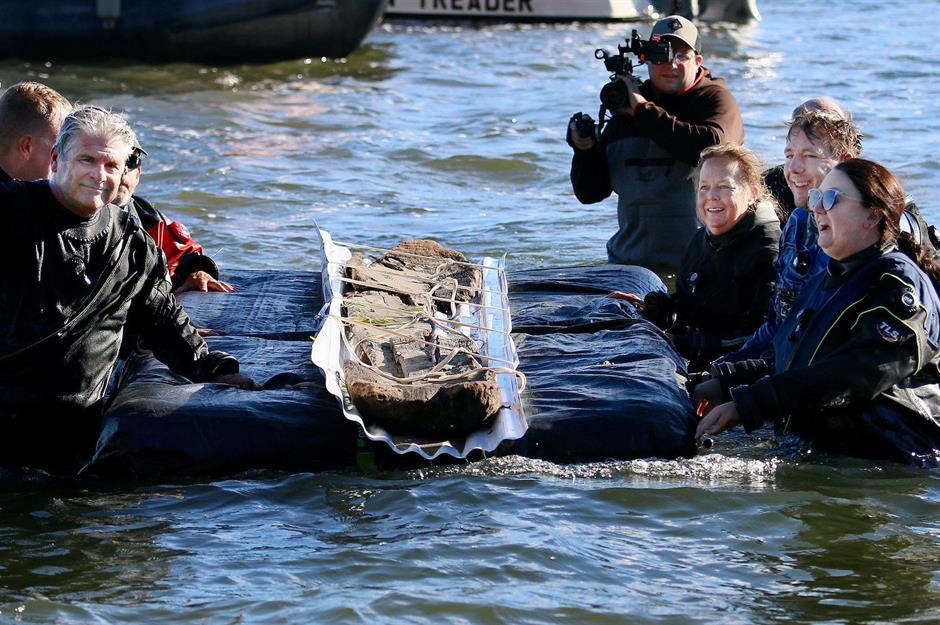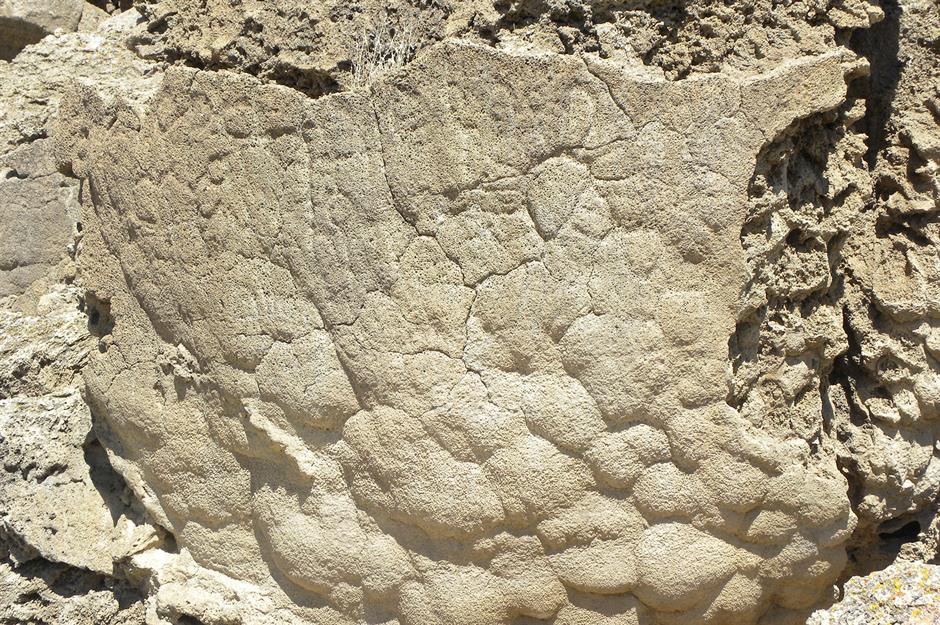America’s most important archaeological discoveries
Fascinating finds
America might be a relatively young nation, but its land has been inhabited for thousands of years. Leaving surprising and often mysterious clues about the cultures who created them, these archaeological finds range from tools, currency and ancient dugout canoes to whole settlements.
Read on to uncover some of the most important and interesting discoveries ever made in the United States…
Winnemucca Lake petroglyphs, Nevada
This series of ancient rock carvings in the Great Basin region in Nevada are thought to be more than 10,000 years old, making them some of the oldest examples of rock art on the continent. Depicting a variety of animals, symbols and human figures, they were created by pecking and scratching the rock surface with stone tools. Studied extensively by archaeologists, the concentric circles known as spirit circles (thought to represent shamans) are among the most intriguing symbols. The petroglyphs are often cited as the first rock art in North America.
Montezuma Castle National Monument, Arizona
Fossilised footprints, White Sands National Park, New Mexico
This striking national park is better known for its blinding white sand dunes, but it's also home to one of the most significant archaeological finds in the United States. Discovered in the 1930s, a collection of fossilised footprints dating back over 10,000 years is evidence of early human activity in the area and offers clues about the hunter-gathering activities of these people. Preserved in a layer of hard, ancient gypsum, the footprints include a range of creatures, from humans to prehistoric elephants, horses and even camels.
Love this? Follow our Facebook page for more on incredible discoveries
Clovis points, New Mexico and others
Clovis points are a collection of prehistoric stone tools, named for the Clovis culture and the New Mexican town where they were discovered in the 1920s. They were used by the Clovis peoples over 13,000 years ago and for a long time it was thought that these might be the first humans in North America. The distinctive tools are characterised by long, fluted blades and pointed tips, and are typically made from a type of fine-grained stone called chert. They're thought to have been used for hunting large animals like mammoths, mastodons and bison. The discovery is one of the most significant in North America as it helped map human history on the continent.
Cactus Hill Archaeological Site, Virginia
One of the oldest known human habitation sites in North America, Cactus Hill dates back at least 18,000 years. The site wasn't excavated until the 1980s when archaeologists started to study the area, finding stone tools made from rhyolite and chert, as well as firepits and animal bones. Curiously, the tools were similar to those from the Clovis site, although the two cultures most likely never met. The discovery was significant as it solidified the theory that the first people arrived in North America by travelling along the shoreline instead of crossing a land bridge as was previously thought.
Alamosaurus, Big Bend National Park, Texas
One of the most remarkable dinosaur discoveries in America, a 70-foot (21m) sauropod known as an alamosaurus was revealed in Big Bend National Park in 1999. The massive creature, which weighed over 30 tonnes, roamed the area before the mass extinction 65 million years ago and was a relatively fast and agile herbivore. Pictured is the reconstructed skeleton next to a T-rex at Dallas' Perot Museum of Nature and Science.
Kinishba Ruins, Arizona
Poverty Point World Heritage Site, Louisiana
Kennewick Man, Washington
The most significant human remains found in the United States, Kennewick Man is a skeleton excavated in 1996. The remarkably well preserved bones date back over 9,000 years. Sparking hot debate between scientists and Native American tribes about the ownership of the remains, the Kennewick Man was the subject of a legal battle that ultimately favoured the scientists. Since the discovery was first made, it's proven invaluable for the analysis of the origins and migration of early humans in North America.
Sand Island Petroglyphs, Bluff, Utah
A snapshot of Native American life in North America before European arrival, this petroglyph panel dates back over 1,000 years and is an exquisite example of ancient art. Located on the banks of the San Juan River, the panel is carved into a sandstone cliff and features depictions of both daily life and spiritual beliefs, including motifs of animals, human figures, abstract designs and celestial objects.
Serpent Mound Historical Site, Ohio
Made up of several layers of earth and stone, the giant serpent-like figure, which extends for more than 1,300 feet (396m), has puzzled archaeologists and historians for decades. It's thought the mound was constructed as a religious or ceremonial site over 1,000 years ago by Indigenous peoples of the area. Designed to align with the positions of the sun and the stars, it is speculated that the mound played an important role in the spiritual and cultural practices of the people who built it.
Judaculla Rock, Cullowhee, North Carolina
A stunning example of the ancient petroglyph art of the Cherokee people, the carved rock is thought to have been created over 3,000 years ago for spiritual purposes. It's covered in hundreds of ancient symbols and images, like animal tracks, human figures and depictions of Judaculla himself – ruler of all game animals in Cherokee mythology.
Hohokam Canal System, Arizona
Over 500 miles (805km) long, this remarkable irrigation system transformed the desert landscape of southern Arizona, allowing the Hohokam people to cultivate crops and establish settlements. The prehistoric culture existed from circa 300 BC to AD 1450 and the advanced canal system is incredible evidence of their ingenuity. The canals were carefully designed to follow the natural contours of the land, allowing rivers and springs to provide water. Today, about half of Arizona's canals originated from Hohokam's irrigation system.
Moundville Archaeological Site, Alabama
SunWatch Indian Village, Ohio
A happy accident, this ancient settlement was rediscovered in 1971 during a construction project. Later excavated by archaeologists, the remains of a village were found, occupied by the Fort Ancient culture from around AD 1000 to AD 1450. A range of structures, including houses and storage pits were uncovered – however, the most significant discovery was the network of wooden posts that were built around the main plaza to align with the rising and setting sun on summer and winter solstices. Today, a reconstruction of the village is open to visitors.
Cliff Palace, Colorado
Horseshoe Canyon rock art, Canyonlands National Park, Utah
Carved into the remote desert landscape of eastern Utah, Horseshoe Canyon is home to a notable collection of rock art dating as far back as 8,000 years. The artwork is characterised by its large, abstract human and animal figures painted in shades of red, black and white. The art suggests the people who created it had a complex culture and belief system. Its use of colour is also unique among prehistoric rock art.
Bandelier National Monument, New Mexico
Meadowcroft Rockshelter, Pennsylvania
Known as one of the most significant prehistoric sites in North America thanks to its careful preservation, Meadowcroft was discovered in the 1950s and has been a key location for the study of early human habitation. Dating back more than 16,000 years, the rockshelter harboured a wealth of artefacts, from stone tools to weapons, that tell the story of the life of early humans in the area. Pottery, plant and animal remains, and a hearth – one of the earliest to be discovered in North America – have all been excavated from the site.
Blythe Intaglios, Colorado Desert, California
A series of massive geoglyphs, just like the famous Nazca lines in Peru, the figures are etched into the desert floor with the largest measuring over 170 feet (52m) in length. A stunning example of prehistoric land art, the exact date of creation isn't known, but it's estimated it could date as far back as 2,000 years and can be credited to the Mojave people. Created by removing the darker top soil to reveal the lighter earth beneath, the figures depict several animals, a snake, a bird and a human.
The Maine penny, Maine
While it might not seem like much, this penny could possibly be evidence that Vikings came to America not only to explore, but also for trade. The coin was discovered in 1957 and is believed to date back to the 11th century.
Dighton Rock, Massachusetts
Spears at Cooper's Ferry, Idaho
Cooper's Ferry is the site of a significant discovery that points to human activity in North America more than 13,000 years ago – the spear points found here are among the oldest human technology ever to be uncovered on the continent. Created using a technique called flintknapping, the stone (typically chert, jasper or basalt) is shaped and sharpened using a series of precise blows. The site is still being excavated and the spearheads studied in the hopes of providing more clues as to the lives of the first humans in North America.
Folsom site, New Mexico
Cahokia, Illinois
Lake Winnipesaukee mystery stone, New Hampshire
Discovered buried close to Lake Winnipesaukee in 1872, the small, egg-shaped stone and its origins have proven to be a mystery that's hard to solve. Approximately four inches (10cm) long and two-and-a-half inches (6cm) in diameter, the stone is covered in a series of carvings and various geometric shapes. Some believe the stone was used as a tool for astronomical observation or ceremonial purposes; others think it's a map for divination. It has even been suggested to have extraterrestrial origins. Whatever it is, it's one of the most curious ancient finds in the United States and has fascinated people for decades.
Chaco Culture National Historical Park, New Mexico
Encompassing a series of ruins and structures built by the ancestral Pueblo people between the 9th and 12th centuries, Chaco Canyon is a UNESCO World Heritage Site and a significant reminder of how advanced the culture was. The largest of the great houses, Pueblo Bonito contained over 600 rooms and was home to around 1,000 inhabitants at its peak. Constructed from large sandstone blocks, these great houses featured multiple levels, hundreds of rooms and intricate masonry work.
Rimrock Draw Rockshelter site, Oregon
In July 2023, archaeologists discovered the earliest known evidence of human habitation in the western United States – stone tools and tooth fragments from an extinct species of camel that date back around 18,000 years. The groundbreaking finds were uncovered at the Rimrock Draw Rockshelter, outside the town of Riley in Oregon, and surpass even the 16,000-year-old settlement at Cooper's Ferry in Idaho – until now the oldest known site in western North America – and Oregon's 14,000-year-old Paisley Caves.
Dugout canoe, Lake Mendota, Wisconsin
When a scuba diving instructor stumbled across a carved tree trunk at the bottom of Lake Mendota in May 2022, maritime archaeologists quickly confirmed that it was a dugout canoe carved from a single piece of oak. The same instructor had found something similar the year before, but radiocarbon dating indicated that this craft was built around 1000 BC, making it the oldest ever canoe found in the Great Lakes region by more than 1,000 years.
Read on for more incredible ancient ruins in the US you probably didn't know about...

